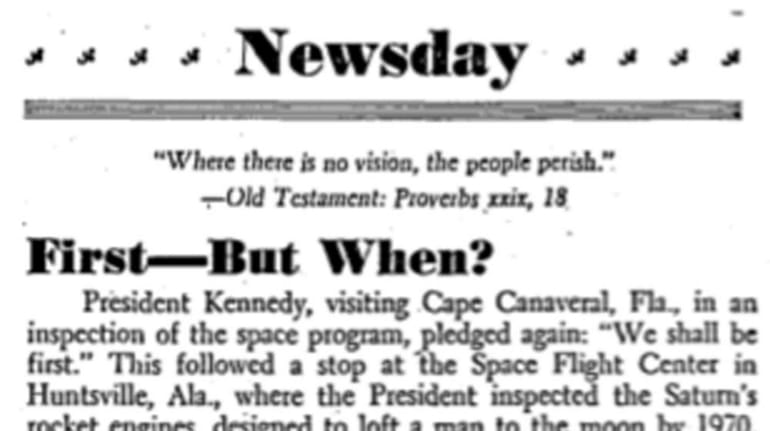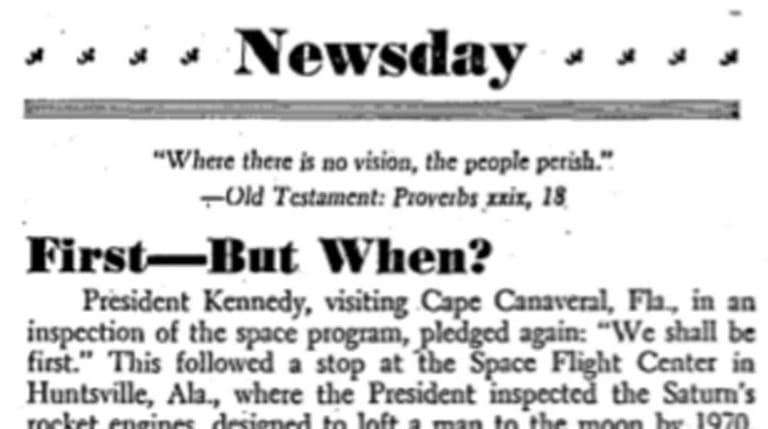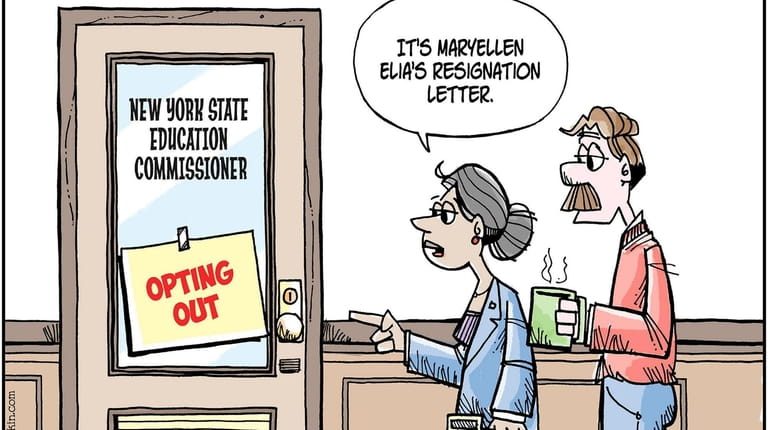To the moon and back to LI

An editorial that ran in September 1962. Credit: Newsday archive
Daily Point
BeLONG on Long Island
For decades, the region’s advocates have debated how to best attract tourism, new business, and new residents to Long Island.
The newest effort to work on all three starts with a new slogan: “BeLONG on Long Island.”
And if that playful, gimmicky phrase doesn’t quite do the trick to convince new businesses to come to Long Island, the region’s tourism group, Discover Long Island, is trying another route. The group, led by Kristen Jarnagin, is partnering with all eight of the Island’s Industrial Development Agencies to apply for a $50,000 grant from National Grid that, Jarnagin told The Point, will help the coalition develop a new campaign.
For a group of IDAs that usually compete with one another for the same businesses, or focus on retaining the ones they have, this is an unusual move.
Jarnagin said the joint effort began after Amazon abandoned its plans to develop a headquarters in Long Island City. At a post-mortem meeting held at the Long Island Association, Jarnagin and IDA representatives first gathered to discuss how to do things differently. Discover Long Island soon offered to take the lead on developing a partnership, and representatives from both Suffolk and Nassau counties helped to bring the eight IDAs under the same umbrella.
“We definitely understand the connection between tourism and economic development,” Jarnagin told The Point.
The eight IDAs would put in a total of $50,000, matching the National Grid grant, if it’s approved, toward a campaign that will create a logo, a website, and a marketing effort. Discover Long Island also is applying for a state Regional Economic Development Council grant of $500,000 to further expand the effort.
The IDA partnership isn’t a done deal yet, as all eight IDA boards must approve it.
Jarnagin said the campaign eventually could reach Philadelphia, Boston and Washington, D.C. To start, it would concentrate on three key industries -- pharmaceuticals, food manufacturing and aerospace.
Perhaps that new focus will mean the IDAs will move away from giving tax breaks back to storage facilities and auto dealerships.
Unless more of them “BeLONG on Long Island,” too.
- Randi F. Marshall @RandiMarshall
Talking Point
'To achieve our aims will take a miracle'

An editorial that ran in September 1962. Credit: Newsday archive
The first landing on the moon took place 50 years ago this weekend, but the challenge that led to the lunar mission was issued eight years earlier by President John F. Kennedy, in a speech to Congress in 1961.
It was time, Kennedy said, “for this nation to take a clearly leading role in space achievement” and beat the Russians to the moon.
Newsday’s editorial board “heartily” agreed. Writing on May 26, 1961, the board joined with JFK in stating the importance of fighting “the Communist threat in the areas of space, foreign aid, disarmament, defense and Latin America.”
Kennedy’s request for $531 million to begin the effort to put a man on the moon by the end of the decade was one of “a series of desirable and acceptable goals,” the board wrote. “We hope Congress and the people will consider his requests carefully — and approve most of them. To do otherwise would be to gamble with the future of the free world.”
Sixteen months later, as JFK traveled around the country drumming up support for the moon mission, the board, always full-throated about the dangers of the Cold War and the Communist threat, cautioned that it would take more than rhetoric to get us there first, invoking the urgency that spurred the Manhattan Project that produced nuclear weapons during World War II.
“It will take a far greater amount of the national income than has so far been invested; it will take prodigies of accomplishment to overcome the immense lead the Russians appear to have,” the board wrote on Sept. 13, 1962. “To achieve our aims will take a miracle.”
It also would require contributions from every American, the board wrote.
“The national will must support the President if we are to be the first on the moon and the first in space,” the board wrote. “This means a degree of sacrifice many of us are unwilling to face. It means higher taxes, no cutback in working hours, a willingness to forego new roads and other public works to which we have become accustomed. It means an end to fat living and fat thinking. Do we have the courage to face up to that challenge?”
Less than seven years later, we had the answer.
- Michael Dobie @mwdobie
Pencil Point
Opting out

Matt Bodkin
For more cartoons, visit newsday.com/opinion
Pointing Out
It’s hot
If you ever feel like telling the grandkids, “In my day, we didn’t even have a heat index! We just had to guess how hot it felt by weighing our sweat!” here is the evidence to back up your claim.
This particular misery measure was not invented until 1978, and took years to catch on.
The creator was legendary WXJT-TV meteorologist George Winterling who was on air for five decades. Winterling originally called it the humiture (a Canadian version is known as the humidex). The purpose was to express how hot weather might feel differently to humans and animals based on high or low humidity levels, just as the wind chill measure calculates how cold given temperatures feel depending on how hard the wind is blowing.
So, for instance, when the temperature is 90 degrees Fahrenheit, and the humidity is 50 percent, the heat index is 95. At 60 percent humidity it is 100, at 70 percent it is 105, at 85 percent it is 117 and at 100 percent it is 132.
All of this is going to hit home on Long Island this weekend as temperatures are expected to hit the mid-90s and heat indexes could touch 110. It could trigger fond reminiscing about winter windchills.
That measure, by the way, was invented in 1945 by two Antarctic explorers, Paul Siple and Charles Passel, and also began to be popularized in the late 1970s.
Before that, our grandparents could only quantify the distance they had to walk to and from school and the height of the snow they walked through (typically three miles each way through two feet of snow) but not the amount of agony the wind added to the cold.
- Lane Filler @lanefiller
Correction: IDAs award tax incentives to businesses. An earlier version of this item incorrectly called the awards grants.
